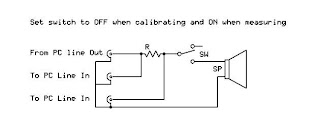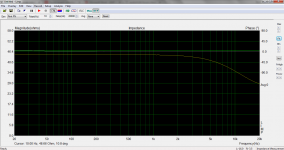VaNarn, I don't doubt the Clio impedance measurement data of Z and theta. Those are correct but I am curious as to why some use Re (dcr of voice coil) and some Re(f). I have looked at Dayton Audio RS 180-4 and RS 270P-4, both of these are calculated through DATS with dcr of voice coil. Would someone have the will to ask Dayton Audio why is it so and I will contact Audiomatica for I am a long term owner and if there is anything wrong with formulae I'd like to be compensated for so I can buy a new board, cheaply! Ha ha ha.
Ha ha ha.
 Ha ha ha.
Ha ha ha.Hey guys I'm looking for a new usb/firewire souncard for Windows10 to make measurement, thanks in advance for kind advice.
http://www.diyaudio.com/forums/equipment-tools/305894-advice-soundcard-measurement.html
http://www.diyaudio.com/forums/equipment-tools/305894-advice-soundcard-measurement.html
Hey guys I'm looking for a new usb/firewire souncard for Windows10 to make measurement, thanks in advance for kind advice.
You may be surprised at how well an onboard sound nowadays works. You can also look at FocusRite Scarlett 2i2o or even a Behringer UCA202
I have access to the Clio win7 version running on a computer with a XP platform. I find the measurements are accurate and the feature of being able to zoom the cursor to a selected frequency and the ability to expand the readings makes it very easy to transcribe measurements. I am reasonably certain that the misuse of the D.C. resistance began with the adoption of the equation that appeared in the Mullard/Philips book "Transistor Audio and Radio Circuits", in 1969. In a paper* "Constant-Voltage Crossover Network Design", Richard H. Small shows a cct. which he names as a 'voice-coil inductance equalizer'. In the article he supplies the now familiar equation Ceq=Le/Re^2. The assumption is made that Req=Re.VaNarn, I don't doubt the Clio impedance measurement data of Z and theta. Those are correct but I am curious as to why some use Re (dcr of voice coil) and some Re(f). I have looked at Dayton Audio RS 180-4 and RS 270P-4, both of these are calculated through DATS with dcr of voice coil. Would someone have the will to ask Dayton Audio why is it so and I will contact Audiomatica for I am a long term owner and if there is anything wrong with formulae I'd like to be compensated for so I can buy a new board, cheaply!Ha ha ha.
I do not think that Audiomatica mentions the equation anywhere in the User's Manual; nor does Joseph D'Appolito in his book "Testing Loudspeakers" of circa 1998.
* I.R.E.E.A., Sydney,May1969 and J.A.E.S., Jan., 1971
Hey guys I'm looking for a new usb/firewire souncard for Windows10 to make measurement, thanks in advance for kind advice.]
For impedance measurements UCA202 works fine for me...after calibration, though it has no potentiometer on any input.
It has no mike input nor phantom power, but i dont need as for frequency response i use minidsp usb mike with any output, the phone output of the pc being ok.
The mini dsp unit is sold with calibration data, 2 files, one in horizontal position pointing at driver, the other in vertical postion.
Last edited:
Merlin, it seems i have found where you picked your schematic.
From the wrong place!
AudioBlog: A simple loudspeaker measurement jig for ARTA
The guy has really no idea of whats involved in the calibration process. He seems to believe that the user is in charge of the calibration adjusting pots level so that he gets a plausible value for the resistor he is measuring, bla bla bla...
In fact the user does not have to do anything: simply let Limp calibrate ITSELF by using the Record / Calibrate menu.
In case Limp finds an imbalance >2dbs he will ask you to adjust levels because it cannot calibrates ITSELF well enough.
It seems that with the 1ohm resistor you have tried to follow its bad tutorial... These things happen following many bloggers...
From the wrong place!
AudioBlog: A simple loudspeaker measurement jig for ARTA
The guy has really no idea of whats involved in the calibration process. He seems to believe that the user is in charge of the calibration adjusting pots level so that he gets a plausible value for the resistor he is measuring, bla bla bla...
In fact the user does not have to do anything: simply let Limp calibrate ITSELF by using the Record / Calibrate menu.
In case Limp finds an imbalance >2dbs he will ask you to adjust levels because it cannot calibrates ITSELF well enough.
It seems that with the 1ohm resistor you have tried to follow its bad tutorial... These things happen following many bloggers...

Well after checking with my UCA202, i must admit that i have over estimated the need to do the calibration process setting the box in calibration mode, as explained in the Arta doc.
Even with the high reference resistor i use (100 Ohms) the differences i find are of a fraction of a ohm.
I still find the blog a bit misleading as it calls "calibration resistor" the "reference resistor" suggesting that this resistor and the volume controls play some role in the calibration process. The UCA202 has no vol control and works perfectly without.
Even with the high reference resistor i use (100 Ohms) the differences i find are of a fraction of a ohm.
I still find the blog a bit misleading as it calls "calibration resistor" the "reference resistor" suggesting that this resistor and the volume controls play some role in the calibration process. The UCA202 has no vol control and works perfectly without.
Felipe, slow down with sound card exchange. Might not be necessary.
Thank you for advice, do you know if I need Arta jig to do fine measurements?
I have been using the M-Audio Mobilepre in the past with Arta, no problem.
But maybe Merlin's unit is defective. This should be more easily detected testing how it plays and records music, or making loopback freq measurements on each entries, etc...
If it has only been used for hard to believe measurements a couple of times, it's a bit hard to say if the unit is ok or not...
But maybe Merlin's unit is defective. This should be more easily detected testing how it plays and records music, or making loopback freq measurements on each entries, etc...
If it has only been used for hard to believe measurements a couple of times, it's a bit hard to say if the unit is ok or not...
Last edited:
- Home
- Loudspeakers
- Multi-Way
- Calculating driver inductance from Limp

